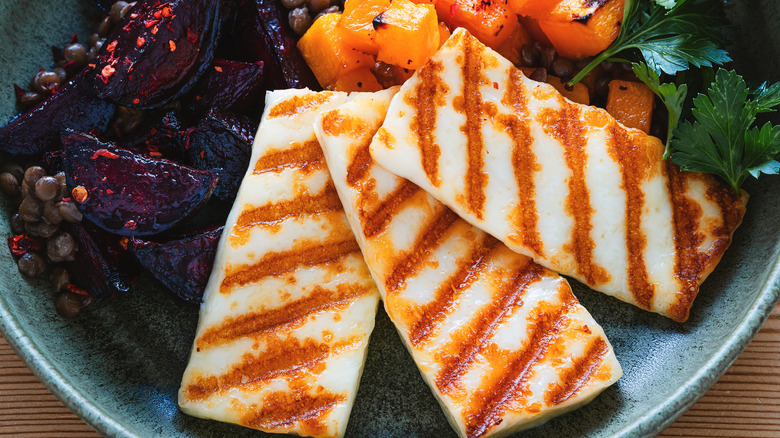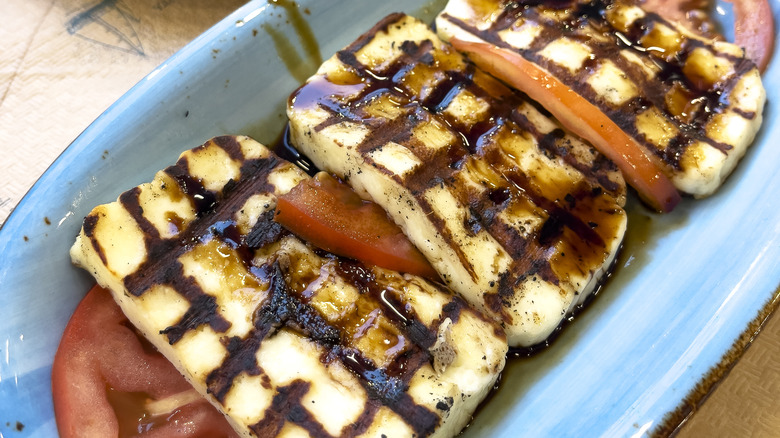Queso De Freir Vs Halloumi: The Difference Between The 2 Frying Cheeses
When it comes to frying cheeses, there's plenty of love to go around. From flaming saganaki to crispy, chewy fried cheese curds — which are much older than you'd think — the combination of high heat and cheese is a guaranteed winner. So much so that Wisconsin Cheese gushed, "A fried cheese ... is one of the great pleasures of the cheese life."
If you are ready to embark on your own frying cheese odyssey, the first item to cross off your list is choosing the star of the dish. Ideal candidates for frying have a high melting point and low acidity to ensure that they maintain their structure and don't turn into goo in the face of hot oil. Both halloumi and queso de frier fit the bill. Halloumi is a Mediterranean cheese that is considered perfect for grilling or frying. Queso de freir (also called queso para freir), is a Caribbean and South American variety that shares characteristics, like a crunchy crust and luscious inside when fried. There's a big difference between the two, however: Queso de freir is less expensive and much easier to find than halloumi.
What you need to know about halloumi
Made from the milk of sheep, cows, or goats, halloumi hails from Cyprus and distinguishes itself with its milky color, firmness, and briny flavor. It is not only delicious but packed with nutritional benefits as well: It's a great source of calcium, which promotes healthy bones and may lower your risk of Type 2 diabetes.
Halloumi is a fantastic protein choice for those trying to cut back on meat — although it is not fully vegan due to the rennet involved in production. And like a juicy steak, it tastes amazing when marinated prior to cooking. Beloved in the Mediterranean, India, and the Middle East, halloumi is often enjoyed on skewers — it also squeaks when eaten! Try a bit of fried halloumi anywhere you would like an umami kick, such as in a crouton, a savory appetizer, or sliced into cheesy fries.
The biggest downside of halloumi is that it is pricey and can be hard to source. Some American grocers, like Trader Joe's, only stock halloumi at certain times of the year. Other major retailers don't carry it at all, leaving only specialty markets that may or may not be available. And when halloumi is found, its comparatively high price tag can be a turn-off for consumers.
Queso de freir is accessible and more budget-friendly
On the other hand, many big-name supermarkets carry queso de freir. The Spanish name literally translates to "cheese for frying." Like halloumi, queso de freir is white in color and firm in texture. It behaves the same when fried, toasting up beautifully on the surface while staying silky and soft in the middle. The two cheeses offer similar nutritional profiles too.
In Latin America, queso de freir is frequently prepared "a la plancha," the closest equivalent to which is grilling, though it also fries gorgeously. In fact, slabs of fried queso feature prominently in a traditional Dominican breakfast. Called "los tres golpes," it consists of mashed plantains, fried salami, sunny-side-up eggs, and, of course, queso de freir, lovingly crisped to a golden hue.
When you are frying your own cheese at home, remember some simple tips. First of all, freeze the cheese prior to submerging it in oil. This will help it achieve that perfect dichotomy of crispy outside without ruining the inner consistency. If, for some reason, your cheese melts, consider coating your second batch in a light layer of cornstarch. This should help it hold its shape. Rely on visual and tactile cues to let you know when your frying cheese is perfectly cooked and ready to enjoy.


